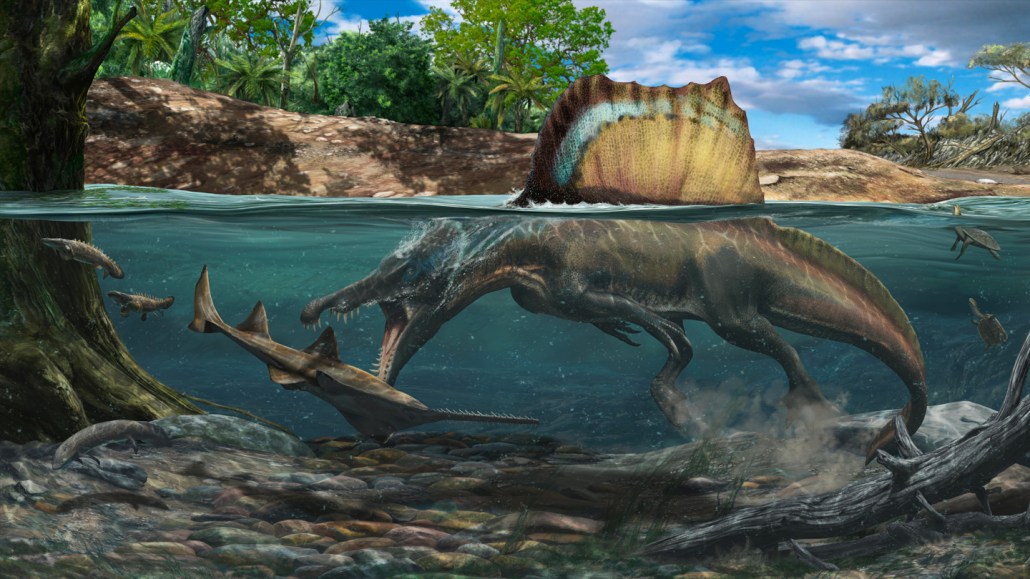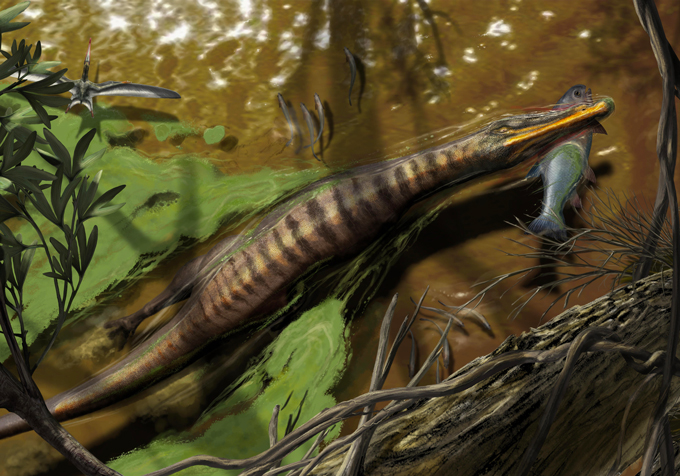Spinosaurus’ dense bones fuel debate over whether some dinosaurs could swim
A new study suggests yes, but it won't be the last word

The dense bones of Spinosaurus (illustrated) may have helped keep it submerged in water, allowing the dinosaur to hunt prey such as ancient sawfish while swimming.
Davide Bonadonna
- More than 2 years ago
A fierce group of predatory dinosaurs may have done much of their hunting in the water.
An analysis of the bone density of several sharp-toothed spinosaurs suggests that several members of this dino group were predominantly aquatic, researchers report March 23 in Nature.
That finding is the latest salvo in an ongoing challenge to the prevailing view that all dinosaurs were land-based animals that left the realms of water and air to marine reptiles such as Mosasaurus and flying reptiles such as Pteranodon. But, other researchers say, it still doesn’t prove that Spinosaurus and its kin actually swam.
Back in 2014, Nizar Ibrahim, a vertebrate paleontologist now at the University of Portsmouth in England, and colleagues pieced together the fossil of a 15-meter-long Spinosaurus from what’s now Morocco. The dinosaur’s odd collection of features — a massive sail-like structure on its back, short and muscular legs, nostrils set well back from its snout and needlelike teeth seemingly designed for snagging fish — suggested to the researchers that the predator might have been a swimmer (SN: 9/11/14). In particular, it had very dense leg bones, a feature of some aquatic creatures like manatees that need the bones for ballast to stay submerged.
In the new study, Ibrahim and his team returned to that question of bone density to assess whether it’s a reliable proxy for how much time a creature spends in the water. The team assembled “a massive dataset” of femur and dorsal rib bone densities from “an incredible menagerie of extinct and living animals, reaching out to museum curators all around the world,” Ibrahim says.
That menagerie includes spinosaurs like showy, sail-backed Spinosaurus as well as its equally sharp-toothed cousins Baryonyx and Suchomimus. It also includes other groups of dinosaurs, extinct marine reptiles, pterosaurs, birds, modern crocodiles and marine mammals.
The team then compared these bone analyses with the water-dwelling habits of the various creatures in the study. That work confirms that density is “an excellent indicator” for species in the early stages of a transition from land-dwelling to water-dwelling, the team reports. Those compact bones can aid such transitional creatures, which might not yet have features like fins or flippers to help them maneuver in the water more easily, in hunting underwater — what the team calls “subaqueous foraging.”
The analyses also show that not only did Spinosaurus have very dense bones, but Baryonyx did too. That suggests that both of these dinos were subaqueous foragers, the team says. That idea builds on previous work by Ibrahim and colleagues that proposed that Spinosaurus didn’t just spend much of its time in the water, but could actually swim in pursuit of prey, thanks to its odd, paddle-shaped tail (SN: 4/29/20).

The idea of a swimming Spinosaurus hasn’t been convincing to all. In 2021, a study in Palaeontologia Electronica examined Spinosaurus’ anatomy in detail and came to a different conclusion. The dinosaur was not a highly specialized aquatic predator, wrote David Hone, a zoologist and paleobiologist at Queen Mary University of London, and Thomas Holtz Jr., a vertebrate paleontologist at the University of Maryland in College Park. Instead, Spinosaurus may have just waded in the shallows, heronlike, to do its fishing.
The new study has not convinced those skeptics. Spinosaurus has “clearly got very dense bones. This is really good evidence that they’re hanging around in water — but we kind of knew that,” Hone says. “It’s not clear what they’re doing in the water. That’s the contentious part.”
Take hippos, which spend much of their time mostly submerged, Hone says. “Hippos have bone densities entirely comparable to Spinosaurus and Baryonyx, but they don’t eat in the water” and they don’t swim, he adds.
“Everyone has been in agreement that Spinosaurus was more aquatic than other big theropods” like Tyrannosaurus rex, Holtz says. That Baryonyx also had dense bones was a bit of an interesting surprise, he adds.
But dense bones or not, Holtz says, “it still doesn’t turn them into aquatic hunters.” He describes several anatomical features — Spinosaurus’ long slender neck, tilted head and arrangement of neck muscles that suggest a downward striking motion — that point more to a wading creature that hunted from above the water surface than one that chased its prey underwater.
Kiersten Formoso, a vertebrate paleobiologist at the University of Southern California in Los Angeles, says that the new comparison of bone densities among a wide variety of creatures is a valuable addition, one that she anticipates referring to in her own work studying the transition of ancient creatures from land to water. But she too is not convinced that it proves that Spinosaurus and Baryonyx could actually swim.
“I would never detach Spinosaurus from the water,” Formoso says. But, she adds, more work needs to be done on its biomechanics — how it might have moved — to understand how adroitly aquatic the dinosaur might have been.







